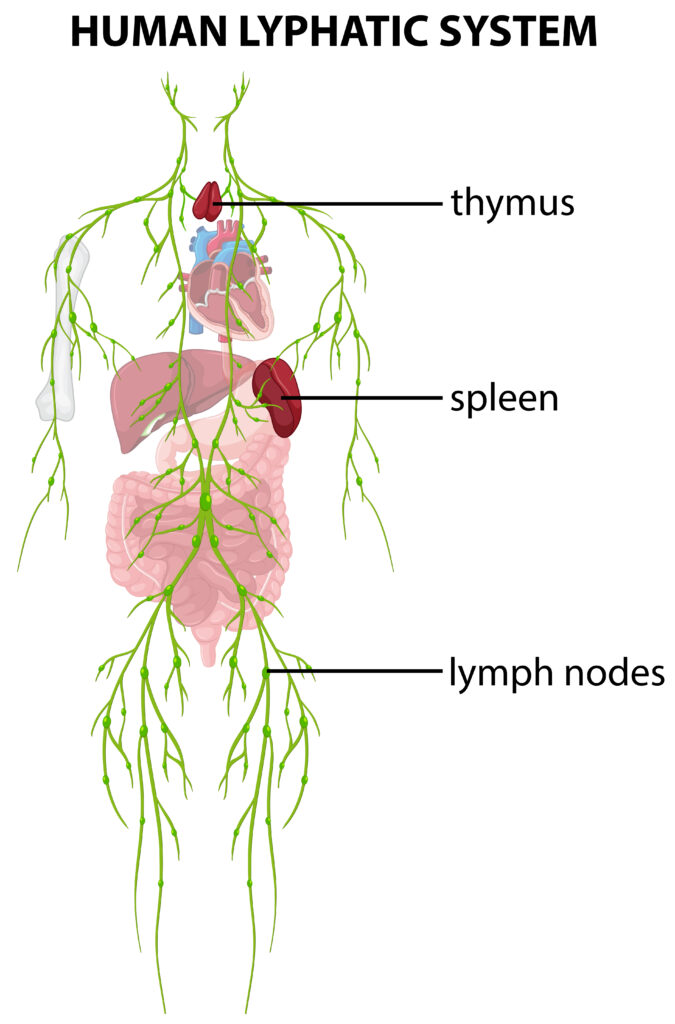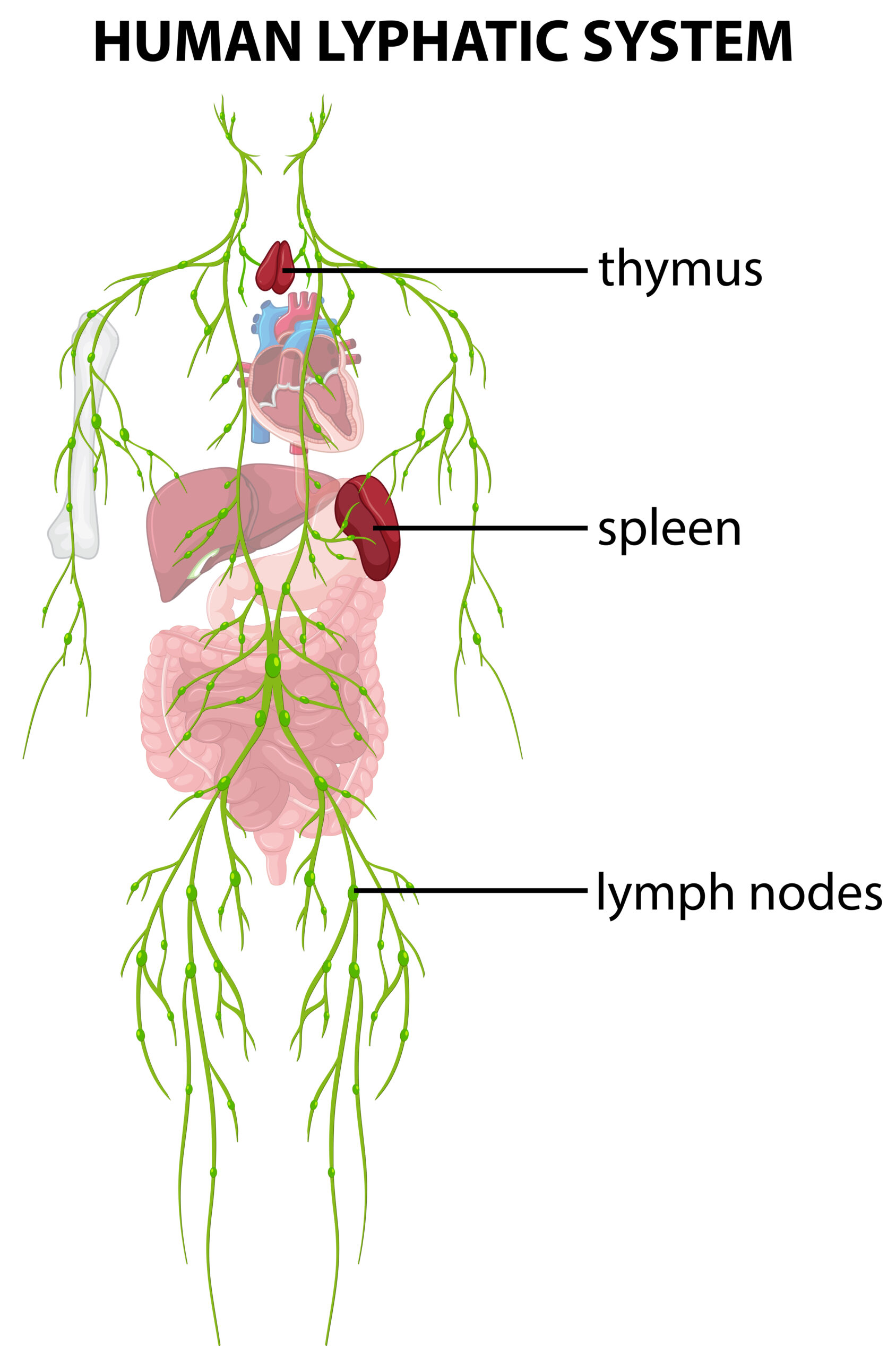
Did you know that your body is kept protected from many diseases by a nonstop working system in the body called the lymphatic system?
The lymphatic system is a subsystem of the circulatory system that consists of lymph (circulatory fluid), vessels, lymph nodes, lymphatic organs, and tissues working together to form a system called the lymphatic system.
Understanding the lymphatic system is very crucial for your health and well-being.
In this blog post we will know what exactly the lymphatic system is, what are its functions in the body, the signs and symptoms when there is a problem with your lymphatic system, and simple ways to support your lymphatic system.
What exactly is the lymphatic system?
The lymphatic system is a subtype of the circulatory system consisting of vessels (lymphatic vessels), lymphatic nodes, organs, and tissues, and the circulatory fluid called lymph, all working together to carry out some important functions of the body.
The lymphatic system acts like a waste management system of the body that carries the leftover portion of blood along with dead cells and bacteria from the tissues and organs.
Key Components and Their Roles:
- Lymph: The circulatory fluid of the lymphatic system is called lymph, which is similar to interstitial fluid. Lymph is composed of water, proteins, fats, cellular waste, and pathogens.
- Lymphatic Vessels: The network of tubes that carry lymph throughout the body, including capillaries, collecting vessels, and trunks. These vessels have valves that are unidirectional to ensure one-way flow of lymph.
- Lymph Nodes: Lymph nodes are filters containing immune cells (lymphocytes) that trap and destroy pathogens and abnormal cells. The common locations of lymph nodes are the neck, armpits, and groin.
- Spleen: The spleen is another lymphoid organ located in the left upper quadrant of the abdominal cavity that helps in filtering blood, storing white blood cells, and removing old or damaged red blood cells.
- Thymus: The thymus is a lymphoid organ; it helps in the maturation of T-lymphocytes (a type of immune cell) that fight foreign objects.
- Tonsils and Adenoids: There are a number of small lymphoid masses in the body in which tonsils and adenoids are included, trapping pathogens entering through the mouth and nose.
- Bone Marrow: Bone marrow is situated in the core of long bones. It has a role in producing lymphocytes that help fight the foreign agents causing diseases in the body.
How does the lymphatic system work?
When the heart pumps blood to the body, it passes through the aorta, main arteries, arterioles, and capillaries.
At this level blood is filtered through the capillaries into the tissues.
This filtered blood contains oxygen, amino acids, glucose, and other necessary nutrients for the tissues to consume.
Most of the filtered blood is absorbed back by the venules and passes through the venous system toward the heart.
While a small portion of the filtered blood is left behind in the tissues.
This leftover blood combines with the waste products of tissues, dead cells, and foreign invaders collectively called lymph now.
The lymph is taken up by the smallest lymphatic vessels present all over the body and travels toward the heart, passing through lymph nodes to filter it and separate the bacteria and dead cells.
This way the leftover portion of blood is again mixed with the blood and helps in fluid regulation.
What are the lymphoid structures?

The lymphatic systems consist of lymphatic vessels, primary lymphoid organs and secondary lymphoid organs for the circulation of fluid (lymph)
Lymphatic vessels
Lymphatic vessels are present all over the body in the form of tubes, the smallest and thinnest being lymphatic capillaries. The lymphatic capillaries absorb the remaining portion of blood in the tissues, waste products of tissues including dead cells, and invading organisms collectively called lymph.
This lymph then travels in the lymphatic vessels toward the heart to meet again with the blood.
Primary lymphoid organs
They are called primary or central lymphoid organs because they generate lymphocytes (two types that are B cells and T cells) from stem cells present in them. It consist of
· Bone marrow:
Bone marrow is responsible for the generation and maturation of both types of lymphocytes and thus helps in the immunity of the body. These lymphocytes produced are used to fight the foreign invaders, e.g., viruses, bacteria, and fungi.
· Thymus:
It is present behind the sternum and is also a primary lymphoid organ. It helps in just the maturation of T-lymphocytes. It is more active from birth to the age of 20 years and then starts to atrophy.
Secondary lymphoid organs
Secondary or peripheral lymphoid organs are those where neither generation nor maturation of lymphocytes occurs. Here lymphocytes become activated by antigen
· Lymph nodes
Lymph nodes are small, bean-shaped glands present all over the body in the course of lymphatic vessels.
In some region it is scattered and in other it form cluster, like in axilla, inguinal, popliteal region, neck, etc.
They act as filters when the lymph passes through them, which filters out the foreign bodies like bacteria, viruses, and fungi and activates the lymphocytes to kill them.
· Spleen
The spleen also acts as a secondary lymphoid organ. Their main functions are
Ø It Produce immune cells called antibodies to fight antigens
Ø It helps in the elimination of worn-out blood cells and particulate matter.
Small masses (appendix, tonsil and Peyer’s patches)
There are other types of secondary lymphoid organs present in the pharynx as tonsils, in the mucosa of the small intestine in the form of Peyer’s patches, as well as the appendix, having roles in giving immunity to the human body.
Main Functions of lymphatic system

The lymphatic system performs a number of important functions in the body, of which the five main functions are
Fluid maintenance of body
The leftover portion of blood in the tissues is absorbed by the lymphatic capillaries, and it travels toward the heart in the lymphatic vessels. These lymphatic vessels form the right lymphatic duct and the left lymphatic duct. The right duct drains the right region of the body (head and neck and part of the limbs, pelvis, perineum, abdomen, and left head and neck region). The ducts finally meet the subclavian veins of the respective sides.
Detoxification
The lymph contains dead and worn-out cells, debris, and foreign objects from the tissues. Through the lymphatic system, it passes from lymph nodes, which filter the cells and debris. The foreign objects (viruses, bacteria, and fungi) also are filtered and killed at the node level and thus help in the detoxification of body fluids.
Role in immunity
The lymphatic system and its organs play a part in the formation and maturation of lymphocytes (B-type and T-type) and play a major part in giving immunity to the human body. When a foreign antigen is presented, then lymphocytes become activated, form antibodies, and help kill the antigen.
Role in fighting diseases
The lymphatic system fights many diseases caused either by the hyperfunctioning of body cells or organs, such as cancers, or by foreign-induced microorganisms like viruses, bacteria, and fungi.
Absorption of fats from intestine
Lymphatic vessels present in the gastrointestinal system absorb fats from the small intestine and then pass them through the lymphatic duct to enter the blood circulation. Fat absorption is an exception to other nutrients, as fats are absorbed by the intestine and pass through portal veins to enter the blood circulation.
Symptoms of a Sluggish Lymphatic System
The common symptoms that may indicate a compromised lymphatic system are
- Swelling (edema), especially in the limbs
- Fatigue and low energy
- Frequent colds and infections
- Digestive issues
- Skin problems (dryness, itching, acne)
- Stiffness and pain in joints
- Brain fog
- Weight gain or difficulty losing weight
Simple Ways to Support a Healthy Lymphatic System
When the lymphatic system becomes compromised, your doctor may advise some lifestyle modifications to incorporate into their daily lives:
- Movement and Exercise: Physical activity like walking, running, yoga, and swimming helps circulate lymph in the body.
- Deep Breathing: Deep breathing, also called diaphragmatic breathing, can stimulate lymphatic flow.
- Hydration: Drink plenty of water to keep lymph fluid moving.
- Massage: Massage of the whole body or parts of it helps in lymphatic drainage massage (self-massage or professional).
- Healthy Diet: Eating a healthy diet rich in fruits, vegetables, and whole foods while limiting processed foods, sugar, and excessive dairy.
- Prioritize Sleep: Always have a sleep routine, as sleep is the natural detoxification process of the body.
- Stress Management: Chronic stress has a negative impact on the immune system as well as the mind. Learning how to effectively deal with stress has a positive impact on the immune system.
Conclusion
The lymphatic system, which begins as part of the circulatory system and performs so many valuable functions, is very important for the overall health and well-being of a person.
By following a lifestyle like regular exercise, having a balanced diet, effectively managing stress, and having a good night’s sleep, you support your lymphatic system, which in turn protects you from so many diseases.
If you feel any of the symptoms discussed above, consult your doctor, and if you find this blog post helpful or have any questions in your mind, feel free to comment or reach out; I will try my best to answer you.


Leave a Reply